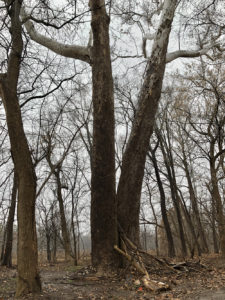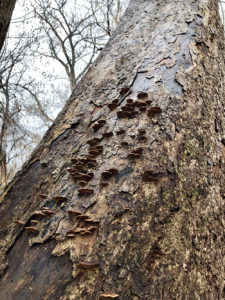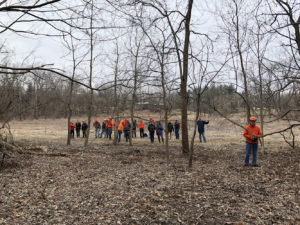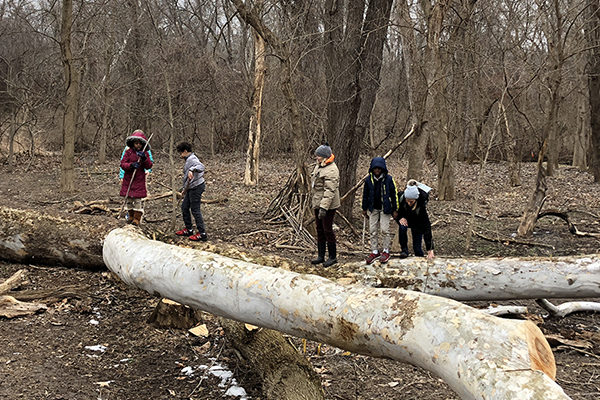 One of the first tasks I had when I started in my role here at LREC back in September was to familiarize myself with the property. I would walk all the trails slowly, looking in all directions to take in as much as I could, as quickly as possible. Starting so late in the season, filling a role that had been left vacant for much of the year, meant there were many things that needed to be done. So, I was trying to learn the property as fast as I could, to be able to prioritize the most important things to be taken care of. After a while of soaking in what was happening on the floor of the woods along the trails, I started paying more attention to the canopy of the woods.
One of the first tasks I had when I started in my role here at LREC back in September was to familiarize myself with the property. I would walk all the trails slowly, looking in all directions to take in as much as I could, as quickly as possible. Starting so late in the season, filling a role that had been left vacant for much of the year, meant there were many things that needed to be done. So, I was trying to learn the property as fast as I could, to be able to prioritize the most important things to be taken care of. After a while of soaking in what was happening on the floor of the woods along the trails, I started paying more attention to the canopy of the woods.
 I had passed by the beautiful patterned trunks of the two massive twin sycamores many times by this point. They were located at one of our only busy trail intersections. It was a spot that children loved to play and build little structures from fallen branches. One such structure laid up against the base of the American sycamores and right alongside the trail. The trunks of these two trees seemed fine from this angle facing the trail. As I looked all the way up to the far reaches of these two majestic trees, I noticed the sycamore on the left had severe dieback in a majority of its canopy. These dead branches would present a hazard above this busy intersection. This sight made me leave the trail and circle back behind the trunk to examine the tree more closely. Unfortunately, I immediately saw many shelf fungi growing on the trunk. This was the second of many other deciding factors to lead me to believe that this tree was a hazard in the heavily used spot it was located on LREC property.
I had passed by the beautiful patterned trunks of the two massive twin sycamores many times by this point. They were located at one of our only busy trail intersections. It was a spot that children loved to play and build little structures from fallen branches. One such structure laid up against the base of the American sycamores and right alongside the trail. The trunks of these two trees seemed fine from this angle facing the trail. As I looked all the way up to the far reaches of these two majestic trees, I noticed the sycamore on the left had severe dieback in a majority of its canopy. These dead branches would present a hazard above this busy intersection. This sight made me leave the trail and circle back behind the trunk to examine the tree more closely. Unfortunately, I immediately saw many shelf fungi growing on the trunk. This was the second of many other deciding factors to lead me to believe that this tree was a hazard in the heavily used spot it was located on LREC property.

These two massive trees were well known by all staff and volunteers and had a special place in their hearts. We decided to get a second opinion from one of the area’s best arborist services before making any final decisions about the tree’s future. The tree service agreed, and the decision was made to bring the tree down in a safe and controlled fall. The tree felling, as well as answering questions about the path to the decision, was able to be turned into a learning experience for the staff and volunteers who were able to watch the event from a distance.
If the tree had been located in an area where it could do no harm, it would have been left standing as a snag. The practice of leaving snags* for wildlife has been happening on site since the founding of LREC. *Snags are incredibly important habitat and food for wildlife, and are nearly non-existent in our densely populated, American urban landscapes. This makes them even more important to leave when you have the chance.
The two sycamore trees had been growing alongside each other for many years, until they finally reached a large enough size to begin touching each other. As the two began growing into each other, they created a perfect little pocket to hold moisture against each other’s base. Then the outer bark and wood began to rot, as the moisture would not dry out fast enough. Once an open wound was created in the base of the two trees, an irreversible decline began. The one tree began losing this battle quicker than the other, and secondary fungi and insects moved into the exposed rotting wood, weakening the already stressed tree even faster. With the large lean the sycamore had, vertical cracks in the rotting base, and the fact that the other sycamore was still trying to push it over, a horizontal crack formed on the side of the trunk. This was a sure sign the tree did not have much time left before its more solid top would take it over.
The felled tree will live on, however. It will still provide food and habitat for our native fauna, and provide a wonderful space for students to climb on, explore, and learn about the circle of life.

Below is a transcription of the linked video:
Trees, Forests, and Landscapes’ chief arborist Mike Sestric, “The reason to take this tree down is there is a lot of rot here, there’s mushrooms growing here which indicate one of many fungal pathogens that does cause the decay, and it’s leaning right towards an area where they have a lot of children playing through here and they bring visitors in to see the natural Missouri bottomlands here. They had expressed some concerns about this fissure here. You can see the two stems have started to split which is very common as twin trunk trees, or even co-dominant stems which are two stems that may be higher in a canopy, begin to push on each other. Then a horizontal crack was noticed which is a serious sign of eminent failure. When we were probing we were able to get it to go all the way in. We are still pretty surprised at the fact that it is standing right now on it own. Any kind of high winds or anything should have knocked this thing down but it’s not. What we are here today to do is get it down controlled and safely.”
LREC volunteer educator Ray Potter, “The tree will definitely not go to waste. This tree here will be here above the ground for quite some years and we will bring the kids over here and they’ll see how a tree produces food. Then when it dies the food is still there and it’s still carried on by the tree, so it’s part of the forest and part of the system. It’s the bugs that will finally take the tree down all the way.”
Mike, “And then we will process it. A lot of materials are going to be left for visitors to come and explore, to see the ecosystem and see what goes on inside a tree as it ages. Even though it won’t be standing, it is still going to be out here for people to enjoy.”
All photos by James Faupel.

